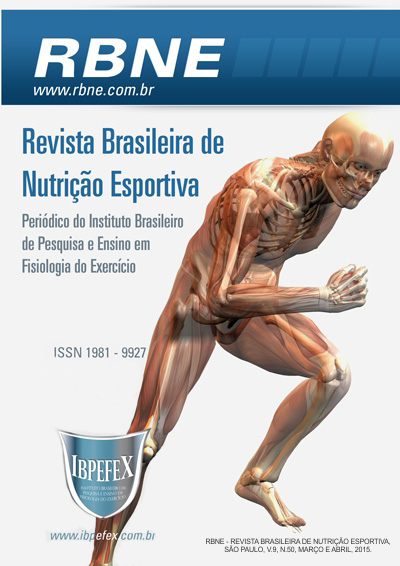Assessment of nutritional and anthropometrics athletes of futsal club Rio Branco-ES
Abstract
Aim: To evaluate the body composition of athletes and the composition of food, checking whether they are consistent with the recommendations for athletes reported. Materials and Methods: Cross-sectional study with 10 athletes of indoor soccer, performing anthropometric measurements, skinfold measurement and individual interviews to recall the application 24 hours for quantification of body composition and food. Results: The majority of the sample meets the appropriate BMI, however, 40% of players have fat percentage above recommendations. The mean total energy expenditure of athletes is 4110.19 kcal / day, but the same only perform intake of 55.5% of the total. Through statistical analysis, it is improper tosay that there is a correlation between the variables, macronutrient intake and body fat percentage. Conclusion: Although most athletes are in normal range with the Body Mass Index, there are still players with the percentage of fat above recommended, therefore, there is need to adjust the calories and composition of the diet of athletes and the development of actions nutrition education so that there is clarification and improvement in eating habits as well as promoting health and physical development of the athlete.
References
-Arruda, E. L. M. A.; Lopes, A. S. Gordura corporal, nível de atividade física e hábitos alimentares de adolescentes da região serrana de Santa Catarina, Brasil. Revista Brasileira de Cineantropometria e Desempenho Humano. Vol. 9. Núm. 1. p. 5-11. 2007.
-Flores, T. G.; Mattos, K. M. Análise de macronutrientes e índice glicêmico consumidos nas refeições antes, durante e após o treino por atletas de futebol profissional de Camaquã-RS. Revista Brasileira de Nutrição Esportiva. São Paulo. Vol. 5. Núm. 29. p. 394-401. 2011.
-Guerra, I. Importância da alimentação e da hidratação do Atleta. Revista Min. Educação Física. Viçosa. Vol. 12. Núm. 2. p. 159-173. 2004.
-Guerra, I.; Soares, E. A.; Burini, R.C. Aspectos nutricionais do futebol de competição. Revista Brasileira de Medicina do Esporte. Vol. 7. Núm. 6. 2001.
-Lakatos, E. M.; Marconi, M. A. Fundamentos de metodologia científica. 4ª edição. Revista e ampliada. São Paulo.Atlas. 2001.
-Leal, G.K. B. Avaliação do estado nutricional de jogadores de futebol profissional em um clube do Rio de Janeiro. Revista Digital. Buenos Aires. Ano 18. Núm. 179. 2013.
-Müller, C. M.; Alves, C.P.; Rostirolla, L.; Navarro, A.C.; Navarro, F. Avaliação do estado nutricional de jogadores de futebol. Revista Brasileira de Nutrição Esportiva. São Paulo. Vol. 1. Núm. 1. p. 30-39. 2007.
-Nascimento, O. V.; Alencar, F. H. Perfil do estado nutricional do atleta adulto. Revista Fit Perf J. Vol. 6. Núm. 4. p. 242. 2007.
-Novack, L. F. Proposição de equações para a estimativa da Gordura corporal em futebolistas. Projeto de Dissertação de Mestrado. Curitiba. 2011.
-Pentedo, E.G.; Baratto, I.; Silva, R. Comparação entre o índice de massa corporal e o percentual de gordura na avaliação do estado nutricional de atletas do futsal masculino. TCC de graduação na Universidade Estadual do Centro-Oeste. Paraná.2009.
-Pezzi, F.; Schneider, C.D. Ingestão energética e de macronutrientes em jogadores de futebol. Revista Brasileira de Nutrição Esportiva. São Paulo. Vol. 4. Núm. 22. p. 324-329. 2010.
-Pinto, M. R.; Azevedo, V. B.; Navarro, F. Alterações da composição corporal de jogadores profissionais de Futebol do Rio Preto Esporte Clube. Revista Brasileira de Nutrição Esportiva. São Paulo. Vol. 1. Núm. 4. p. 17-24. 2007.
-Prado, W. L.; Botero, J. P.; Guerra, R. L. F.; Rodrigues, C. L.; Cuvello, L. C. Dâmaso, A. R. Perfil antropométrico e ingestão de macronutrientes em atletas profissionais brasileiros de futebol, de acordo com suas posições. Revista Brasileira de Medicina do Esporte. Vol. 12. Núm. 2. 2006.
-Quintão, D.F.; Oliveira, G.C.; Silva, S.A. Marins, J.C.B. Estado nutricional e perfil alimentar de atletas de futsal de diferentes cidades do interior de Minas Gerais. Revista Brasileira de Futebol. Vol. 2. Núm. 1. p. 13-20. 2009.
-Sartori, R. F.; Pates, M. E. F.; Tramonte, V. L. G. C. Hábitos alimentares de atletas de futsal dos estados do Paraná e do Rio Grande do Sul. Revista da Educação Física/UEM. Maringá. Vol. 13. Núm. 2. p. 55-62. 2002.
-SBME. Revista brasileira de medicina do esporte. Suplemento da Revista Brasileira de Medicina do Esporte. Vol. 15. Núm. 2. 2009.
-Schwarz, K.; Freitas, A. R.; Silva, R. Avaliação da ingestão calórica e de macronutrientes de atletas do futsal masculino do município de Guarapuava, Paraná. TCC de graduação na Universidade Estadual do Centro-Oeste. Paraná. 2009.
-Tiveron, R. Z.; Gatti, R. R.; Silva, R. Análise quantitativa e qualitativa da ingestão alimentar de atletas de uma equipe de futsal masculino de Guarapuava-PR. TCC de graduação na Universidade Estadual do Centro-Oeste. Paraná. 2009.
-Valter, C. A. Perfil antropométrico e consumo alimentar de indivíduos com deficiência praticantes de natação e futsal. Revista Digital. Buenos Aires. Num. 150. 2010.
-Zaratim, S. Aspectos socioculturais do Futsal. Revista eletrônica de educação da Faculdade Araguaia. Goiânia. Vol. 2. Núm. 2. 2012.
Authors who publish in this journal agree to the following terms:
- Authors retain the copyright and grant the journal the right of first publication, with work simultaneously licensed under the Creative Commons Attribution License BY-NC which allows the sharing of the work with acknowledgment of the authorship of the work and initial publication in this journal.
- Authors are authorized to enter into additional contracts separately for non-exclusive distribution of the version of the work published in this journal (eg, publishing in institutional repository or book chapter), with acknowledgment of authorship and initial publication in this journal.
- Authors are allowed and encouraged to post and distribute their work online (eg, in institutional repositories or on their personal page) at any point before or during the editorial process, as this can bring about productive change as well as increase impact and impact. citation of published work (See The Effect of Free Access).






